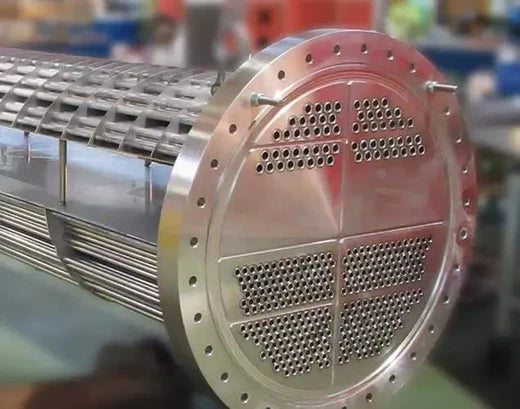
Heat Exchange Market: Innovations Driving Efficiency and Sustainability
Share

Introduction
The heat exchange industry is undergoing a profound transformation, fueled by technological advancements and a growing focus on sustainability. As global energy demands rise and environmental concerns intensify, the industry is embracing new solutions to maximize efficiency, reduce environmental impact, and meet the needs of a rapidly evolving world. From cutting-edge heat transfer mechanisms to the integration of renewable energy sources, the innovations in this sector are reshaping how heat exchange systems operate—and presenting exciting opportunities for investors.
Revolutionizing Efficiency with Smart Heat Exchange Systems
The adoption of smart technologies is revolutionizing the heat exchange industry. Smart heat exchange systems are equipped with sensors, advanced control mechanisms, and real-time data analytics, enabling them to operate more efficiently and adapt to changing conditions. These systems can optimize heat transfer, reduce energy consumption, and increase operational efficiency.
One of the most significant benefits of smart heat exchange systems is their ability to monitor and adjust performance in real time. By leveraging data-driven insights, these systems can respond dynamically to fluctuations in temperature, pressure, and other environmental factors, ensuring optimal performance while reducing energy waste. For investors, the market for smart heat exchange systems represents a high-growth area, with potential applications across industries like manufacturing, HVAC, and renewable energy.
Harnessing the Power of Renewable Energy Sources
A major trend in the heat exchange sector is the integration of renewable energy sources. As the world transitions toward cleaner, more sustainable energy, the need for heat exchange systems that can effectively harness and utilize renewable energy is becoming increasingly important. Solar thermal systems, geothermal heat pumps, and biomass energy solutions are just a few examples of how renewable energy is being integrated into heat exchange processes.
This shift toward renewable energy reflects a broader global movement towards sustainability, driven by the urgent need to reduce carbon emissions and mitigate the impacts of climate change. The growing adoption of renewable energy technologies creates exciting opportunities for investors in the heat exchange industry, particularly in companies developing solutions that combine efficient heat transfer with clean energy sources.
Advancements in Material Science
Material science is another critical area driving advancements in the heat exchange industry. Researchers are continuously exploring novel materials with enhanced properties, such as superior thermal conductivity, corrosion resistance, and durability, to improve the performance and longevity of heat exchangers.
By developing materials that can withstand harsher operating conditions while providing more efficient heat transfer, manufacturers can create heat exchange systems that are not only more effective but also more cost-efficient over time. Innovations in materials like high-performance alloys, ceramics, and composites hold the potential to significantly enhance the performance of heat exchangers and reduce maintenance costs.
For investors, this focus on material science presents an opportunity to engage with companies that are leading the charge in developing next-generation materials for heat exchange systems. As material science continues to evolve, it will play an increasingly crucial role in shaping the future of the industry.
The Integration of Artificial Intelligence (AI)
The integration of artificial intelligence (AI) into heat exchangers is one of the most exciting advancements in the sector. AI-powered systems have the potential to optimize heat exchange processes by analyzing real-time data and adjusting operations based on dynamic inputs and system parameters.
With AI, heat exchangers can self-adjust to changing environmental conditions, fine-tuning their performance for maximum efficiency and minimal energy consumption. AI can also predict and prevent potential issues before they arise, reducing downtime and maintenance costs. This not only improves the reliability and longevity of heat exchange systems but also enhances their overall energy efficiency, making them more sustainable and cost-effective in the long term.
The application of AI in heat exchange technology represents a significant opportunity for investors, especially as industries like manufacturing, automotive, and energy continue to embrace automation and data-driven decision-making. Companies that incorporate AI into their heat exchange systems will be well-positioned to lead in the evolving market.
Conclusion: The Future of Heat Exchange
Looking ahead, the future of heat exchangers is bright, with innovations poised to make systems more efficient, adaptable, and sustainable. Advancements in smart technology, material science, renewable energy integration, and artificial intelligence are transforming the industry, enabling heat exchange systems to operate more effectively while minimizing their environmental impact.
For investors, this rapidly evolving sector presents numerous opportunities. The market for efficient and sustainable heat exchange systems is set to grow, driven by demand from industries seeking to reduce energy consumption and carbon emissions. As technology continues to evolve, heat exchangers will become more reliable and adaptable, seamlessly integrating renewable energy sources and contributing to a cleaner, more sustainable future.
With the ongoing advancements in technology and the growing emphasis on sustainability, the heat exchange industry offers a high-potential investment opportunity for those looking to engage with one of the most dynamic and forward-thinking sectors in modern energy and industrial applications.
As these innovations continue to shape the future of heat exchange, now is the time for investors to explore the opportunities within this transformative industry.